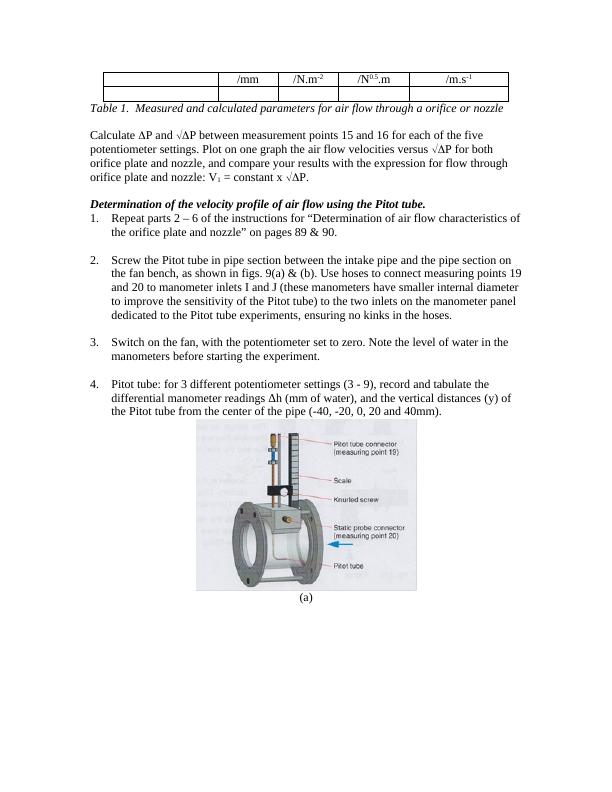Ask a question from expert
Experimental Procedure
7 Pages1944 Words522 Views
Added on 2019-09-25
Experimental Procedure
Added on 2019-09-25
BookmarkShareRelated Documents
Experimental procedureYou are provided with two long and one short 84.6 mm nominal bore PVC pipes, an inletelement and a pipe section with extensions which are flanged at both ends, see fig. 6, a number of nuts and bolts, fexible hoses, a panel of 16 manometers, and an anemometer. An electrically driven air blower is fiited at the end of the pipe section with extensions near to the fan outlet. The flow velocity of air through the pipe assembly varied by changing the potentiometer setting (0 to maximum of 90) on the electrical air blower. Theair flow velocity has been set to increase linearly with the potentiometer settings. Tappings at selected positions in the pipe wall allow for connections to water manometers using the hoses provided, to measure head loss. The anemometer can be positioned centrally at the front of the inlet element, to determine the velocity of the air when required. Use only the I and J inlets on the manifold for experiments using the Pitot tubes.Figure 6. The pipe section without any valves or fittings. The measurement points are numbered.Assembling the pipe sections in the GUNT equipmentThe pipe sections will have been assembled as shown in fig. 6. An orifice plate, nozzle, Venturi tube, two Pitot tubes, an iris diaphragm valve, and three pipe bends are provided and which can be installed at different positions in the pipe sections for the experiments discussed in the individual sections below. Determination of the air flow characteristics of the orifice plate and nozzle1.Unscrew the two long pipe sections at the position shown by the red arrow on fig. 1, and slightly push away the intake pipe which is connected through the short pipe section to the inlet element, giving enough space for the measuring flange which contains the orifice plate or nozzle. Position the intake pipe bench and the fan bench next to each other, and make sure that the pins on the fan bench are guided into the holes on the intake pipe bench. Use the tow clamps to connect the frames to each other. Lock the rollers on the intake pipe bench and the fan bench to prevent them rolling away.2.Install the orifice plate or nozzle into the measuring flange, see fig. 7, by loosening the four screws on the measuring flange, and carefully pulling the right half of the measuring flange to the side. Put the 50mm internal diameter orifice plate or nozzle into the measuring flange until it sits cleanly in the groove (take note of the direction of flow: airflow should be into the wide end of the nozzle). Put the two halves of the

measuring flanges together and bolt them back together. Figure 7. The measurement flange. 3.Screw the measuring flange between the intake pipe and the pipe section on the fan bench, as shown in the Figure 8. Remove the pinhole from the fan outlet. Figure 8. The pipe section with the measurement flange in place. 4.Use the hoses to connect measuring points 15 and 16 to the inlets on the manometer panel, ensuring that there are no kinks in the hoses. 5.Switch on the fan, with the potentiometer set to zero. Note the level of water in the manometers before starting the experiment. 6.Orifice plate and nozzle: for five different potentiometer settings record the differential manometer Δh (mm of water), and measure the corresponding air flow velocities using the anemometer. Treatment of resultsThe velocity of flow of air through is proportional to the square root of the differential head across the manometer. Tabulate your measured and derived values under the headings shown in Table 1.Potentiometer settingsh PPAir velocity

/mm/N.m-2/N0.5.m/m.s-1Table 1. Measured and calculated parameters for air flow through a orifice or nozzleCalculate P and P between measurement points 15 and 16 for each of the five potentiometer settings. Plot on one graph the air flow velocities versus P for both orifice plate and nozzle, and compare your results with the expression for flow through orifice plate and nozzle: V1 = constant x P. Determination of the velocity profile of air flow using the Pitot tube. 1.Repeat parts 2 – 6 of the instructions for “Determination of air flow characteristics ofthe orifice plate and nozzle” on pages 89 & 90. 2.Screw the Pitot tube in pipe section between the intake pipe and the pipe section on the fan bench, as shown in figs. 9(a) & (b). Use hoses to connect measuring points 19and 20 to manometer inlets I and J (these manometers have smaller internal diameter to improve the sensitivity of the Pitot tube) to the two inlets on the manometer panel dedicated to the Pitot tube experiments, ensuring no kinks in the hoses.3.Switch on the fan, with the potentiometer set to zero. Note the level of water in the manometers before starting the experiment. 4.Pitot tube: for 3 different potentiometer settings (3 - 9), record and tabulate the differential manometer readings Δh (mm of water), and the vertical distances (y) of the Pitot tube from the center of the pipe (-40, -20, 0, 20 and 40mm). (a)

End of preview
Want to access all the pages? Upload your documents or become a member.
Related Documents
Measurement of Flow Characteristics of Meters and Control Valvelg...
|15
|2811
|325
Study on Pressure Drop Characteristicslg...
|15
|2857
|185
Fluid Flow Characteristics of Tubes and Plates in a Gunt Flow Systemlg...
|14
|2226
|144
Measurement of Flow Characteristics of Meters and Control Valvelg...
|10
|2009
|375
Report On Pressure Drop Of Airflowlg...
|11
|1883
|215
Forced Convection Heat Transfer: Theory, Apparatus, and Resultslg...
|12
|2492
|452